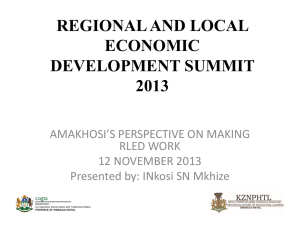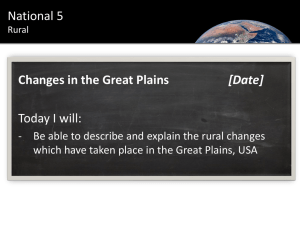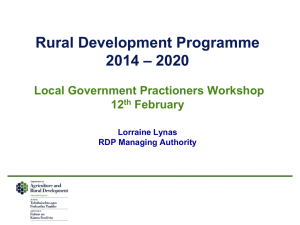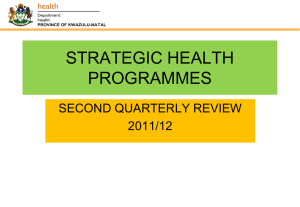Making LED Work For Rural Communities: The Ilembe
advertisement
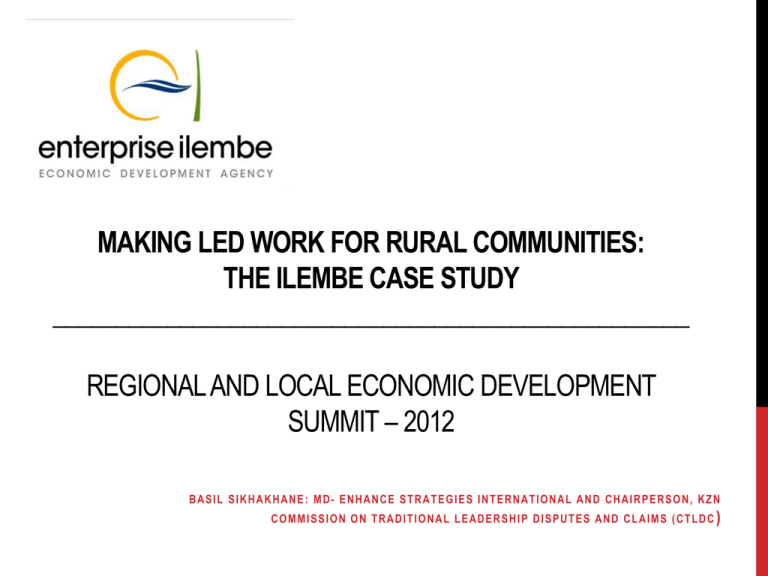
MAKING LED WORK FOR RURAL COMMUNITIES: THE ILEMBE CASE STUDY __________________________________________________ REGIONAL AND LOCAL ECONOMIC DEVELOPMENT SUMMIT – 2012 BASIL SIKHAKHANE: MD- ENHANCE STRATEGIES INTERNATIONAL AND CHAIRPERSON, KZN COMMISSION ON TRADITIONAL LEADERSHIP DISPUTES AND CLAIMS (CTLDC ) LOCAL ECONOMIC DEVELOPMENT IN RURAL AREAS Key Focus Is On Land Productive use Ease of Access to land Commercially viable tenure system(s) Improved value through infrastructure Empowerment of women and children 2 Access to Agri-logistics NATURE OF RURAL COMMUNITIES IN KZN Rural (small) town areas Large-scale commercial farms Small-scale farms __________________________________________________ Rural traditional community areas Excludes small towns Excludes large and small scale commercial farms Carries the bulk of the development and service delivery backlog Vicious cycle of deprivation 3 Looks up to LED for relief RURAL COMMUNITIES IN KWAZULU-NATAL 4 LAND AS KEY A FACTOR OF PRODUCTION: LED CHALLENGES IN RURAL AREAS (AGRICULTURAL CONTEXT) THE AGRI-LOGISTICAL DIVIDE Rural Areas Rural Areas (Traditional Communities) - Farming communities - Generally unsuitable land (commercial & small - Lack of skills scale) - Limited to no access to agri-logistics - Access to agri-logistics - No access to markets - Processing & packaging - Increased market- gardening as opposed to commercial farming 5 - Access to markets STRUCTURAL CHALLENGES (DISTRICTS) o The “duality” challenge Different economies Different communities Differentiated legacies Marginalisation/ expansion o The pressure to address “marginalisation” issues o The need facilitate growth and expansion outside traditional community areas o The need to maximise effort in current opportunities 6 o The creation of ladders between the two economies DISTORTIONS Global trend: 60% small-scale farmers contribution- agricultural production 40% large-scale farmers contribution Bulk support and funding to small scale RSA trends: 95% large-scale contribution 5% small-scale contribution 5% small-scale not necessarily “rural” Bulk support and funding for large-scale Funding/ tenure mismatch 7 ILEMBE DISTRICT CASE STUDY Challenging realities Spatial inequality Dual economy Cycle of deprivation in free-fall mode in rural areas • General development backlog • Service delivery backlog • Poor productivity Shortage of skills Unemployment Poverty Vulnerability 8 ILEMBE APPROACH & PRINCIPLES Acknowledgement of the spatial context of the district Collective/ regional response Family of municipalities as opposed to competing enclaves Acknowledgement of different strengths Capitalizing on the diversified strengths One district one economy 9 Elimination of duality ALIGNMENT Regional alignment Provincial alignment Sector alignment 10 Alignment of regional (district) processes within provincial strategic objectives OPTIONS Local municipality driven LED Local focus Local view Competition Missing out on complimenting advantages Compliance challenges District municipality driven LED 11 Diluted local focus Competency challenges Legislative/ compliance challenges THE DEVELOPMENT AGENCY OPTION Legislative framework 12 Municipal entity Opportunities in addition to PFMA and MFMA Access to different sources of funds Ability to pilot District wide coordination Alignment with IGR framework Shared destiny (regional vision) Coordination of public and private sector efforts Inline with Provincial Growth and Development Plan as a regional planning forum Enhanced accountability measures ILEMBE DISTRICT CASE STUDY The LED Governance & Implementation Model The DM supported by COGTA established a regional Development Agency (Enterprise ILembe) 13 OBJECTIVES OF ENTERPRISE ILEMBE To optimise on the regional competitive advantages of Tourism, Agriculture & Low Impact Manufacturing; To develop creative mechanisms to rapidly achieve BEE targets; To design an organisational vehicle to leverage catalytic economic opportunities; To involve Business In functional regional economic decisionmaking; 14 To leverage all possible resources to the benefit of the ILembe region. FUNCTIONS OF ENTERPRISE ILEMBE Developing and strengthening the local economic development strategy on behalf of the district and local municipalities; Championing a wide range of activities which emerge as important from the LED strategy; Fundraising for specific projects, and potentially project managing some of these; Funding certain services to be applied across the area, eg specialist business advice; Coordinating activities to ensure that an integrated service is provided across providers, eg for business advice; Monitoring and quality control of services available in the area; Directly undertaking certain functions, eg regional marketing; Promoting regional activities, eg collective marketing, regional food brands etc. Facilitating the identification, packaging and implementation of catalytic projects. Provide a professional and multi-skilled support and networking service to major investors who wish to invest in the region by: Working with local government to improve the business enabling environment ; Establishing a research unit to develop and maintain a regional socio – economic and investor database Facilitating the establishment of a Destination Management Office (DMO) in Ilembe. Provide a “turn-key” service to investors who wish to relocate to Ilembe Implement an aggressive business retention and expansion (BR&E) programme coupled with a business development and support (BDS).Priority will be given to those businesses committed to black economic empowerment (BEE) partnerships. Build twinning relationships with developed regions internationally. 15 OPERATIONAL PRINCIPLES 16 The Council and Board of Directors of Enterprise ILembe have set out the following operational principles for the organisation : Bring the poor and previously disadvantaged to the centre of development Build a synergistic relationship between Local Economic Development and Social Upliftment. Build Linkages between the established coastal economies and historically marginalised rural areas. Build a culture of Social, Economic & Environmental interdependency as the first test when evaluating opportunities. (i.e. triple bottom line) Focus LED around realistic catalytic initiatives natural to the region and wherever possible building on the uniqueness of local competitive advantage and market differentiation. Building a capacity to nurture effective and mutually beneficial partnerships based on fair and equitable business principles. Ability to leverage Black Economic Empowerment (BEE) as measured by direct or potential equity and not only new jobs created. GOVERNANCE STRUCTURE Board of Directors Internal Audit Committee External Audit Committee 17 Audit and Risk Committee OPERATIONAL STRUCTURE CEO CFO COO Manager: Trade & Investment Promotions LED Officer: Manufacturing Admin. Support Head: Project Management Unit Admin. Support LED Officer: Arts & Crafts LED Officer: Agric. 18 LED Officer: Tourism 19 DISTRICT FOOTPRINT FUNDING To date the agency has had two core funders of its operational costs, these being the District Municipality (which provides a grant of about R2m) and the Industrial Development Corporation (IDC), (which provides a grant of R3.5m for operational costs). Both these funders have required that the agency progressively develop financial self-sustainability strategies. 20 As regards project funding, the agency presently manages about R15m of project funds from the Provincial Corridor Development Fund (managed by the KZN Dept of Cooperative Governance and Traditional Affairs), and the IDC. ALIGNMENT OF PROJECTS WITH STRATEGIC OBJECTIVES Strategic Objectives: 21 Job Creation Human Resource Development Human & Community Development Strategic Infrastructure Environmental Sustainability Governance And Policy Spatial Equity Job Creation (100%) Human Resource Development (100%) Human & Community Development (100%) Strategic Infrastructure (100%) Environmental Sustainability (100%) Governance And Policy (100%) Spatial Equity (100%) JOB CREATION Unleashing the agricultural sector Enhance industrial development through trade, investment & exports Expansion of government- LED creation programmes Promoting SMME, Entrepreneurial and youth development Enhance the knowledge economy HUMAN RESOURCE DEVELOPMENT Early Childhood Development, Primary and Secondary Education Skills alignment to Economic Growth Youth Skills Development & Life-Long Learning HUMAN & COMMUNITY DEVELOPMENT Poverty Alleviation & Social Welfare Enhancing Health of Communities and Citizens Enhance Sustainable Household Food Security Promote Sustainable Human Settlements Advance Social Capital Enhance Safety & Security STRATEGIC INFRASTRUCTURE Develop-ment of Harbours Development of Ports Development of Road & Rail Networks Development of ICT Infrastructure Improve Water Resource Management & Supply Develop Energy Production and Supply ENVIRONMENTAL SUSTAINABILITY Increase Productive Use of Land Advance Alternative Energy Generation Manage pressures on Biodiversity Adaptation to Climate Change GOVERNANCE AND POLICY Strengthen Policy and Strategy Co-ordination & IGR Building Government Capacity Eradicating Fraud & Corruption Promote Participative, Facilitative & Accountable Governance SPATIAL EQUITY: Actively Promoting Spatial Concentration Facilitate Integrated Land Management & Spatial Planning 22 EXTENT OF LINK WITH STRATEGIC OBJECTIVES 23 LEAD SECTORS KEY TRANSFORMATION OUTCOMES (IN PROJECTS) Ownership Operations Joint ownership of factors of production by local co-ops and technical partners Programme joint ownership of agri-logistics Access to agri-logistics Compliance Access to commercial markets Improved land value 24 Empowerment of women and the youth. PROJECT 1. Agri-Hubs STATUS/PROGRESS This project involves the establishment of four hydroponic (tunnel) farms in the four local municipalities, as well as two nurseries to supply the tunnel farms. Total Budget is R11m. 2. Ilembe Vineyards This project involved the growing of about 12 hectares of vines in 3 local areas of the District – with a view to building a new wine industry on the north coast. Total Budget of R8m has been approved by KZN Corridor Devpt Fund, (R30m was requested). 3. Ilembe Industrial Development Strategy This project involves the development of a District wide plan for the release and development of priority sites for industrial expansion and development. The plan will guide future infrastructure, industrial and related developments. About 6 priority areas have been identified and high-level feasibility for developing these has been done. The project budget of R1.3m was funded by the Provincial Corridor Fund. 4. Ilembe Broadband Project This project involves developing a detailed business plan for the roll-out of affordable (if not free) broadband to both urban nodes and rural areas in the District. A pilot project delivering such cablebased and wireless broadband capacity is also planned. A budget of R3m has been approved for the project. A total of about R30m is required for full broadband roll-out in the District. 5. Ilembe Biodiesel Refinery This project aims to establish a biodiesel processing plant, delivering vehicle-grade diesel from used oil (initially) and ultimately from moringa seed. A budget of R6m has been approved from the KZN Corridor Fund for this project. 6. Mambulu Titanium This project is a feasibility study into the potential for the commercial mining of titanium deposits in the Mambulu area of Maphumulo Local Municipality. A budget of R400 000 is committed to the project. Through this project, Enterprise Ilembe is able to provide the technical support to the process of exploring a viable stakeholder approved solution to the development proposal/s for Macambini. This involves providing research, legal, planning, design, engineering, social facilitation services to the Provincial Team tasked with developing solutions and managing the process. This project proposes the development of a general aviation airport near Darnall. No further progress has been made since the finalisation of the high-level feasibility study which suggested that the closure of Virgina airport was key to the success of a new airport at Darnall. 7. Macambini Project Secretariat 8. Darnall Airport 25 PROJECTS (FUNDED) PROJECTS (UNFUNDED) 9. Sports Legacy Parks 10. Ilembe Blueberries Project 11. Choice Water Bottling 12. Thussong Centre at Shakashead 13. KZN Artspaces 14. Ilembe Mountain Bike Race Hosting proposal 15. Ilembe ICT Programme Management 16. Ilembe BEE Strategy Formulation 17. Aquaculture Project 18. Wind Farming Project 19. Nonoti Master-planning process 20. Cooperatives Strategy implementation 26 In addition to the funded projects above, the Project Management Unit pursues other opportunities for projects which have some level of feasibility, but do not yet have funds for implementation or for piloting. Some of these include : CURRENT/ FUTURE MILESTONES Contractual finalisation(s) of ownership model Pilot results assessment on operational practices Setting up of regional structure to monitor progress Documentation of lessons learnt 27 Sharing SUCCESS FACTORS FOR LED (RURAL COMMUNITIES): WHAT HAVE WE LEARNT District approach Complimenting against competing Diverse strengths against diverse weaknesses Integration (Ownership & Operations) Land-value through productivity Bridging of the agri-logistical divide Skills development 28 Access to commercial markets CRITICAL IMMEDIATE/ FUTURE REQUIREMENTS FOR ILEMBE More pilot projects (in all sectors) Additional funding Training (for co-operatives & other structures) Establishment of Regional Support structure 29 Monitoring ELIMINATION OF DUALITY (CONCLUSION) Addressing the marginalization factors of rural communities Implementing the “one district” approach Traditional rural communities accessing the developed rural area infrastructure Ownership partnerships across the Agri-logistical divide 30 Robust and competent regional structure to support the partnerships 31 THANK YOU


